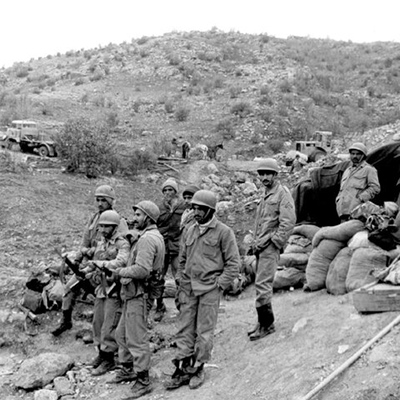Groups, Institutions, Organiza
40th Infantry Brigade of Sarab
Written by: Mohsen Shirmuhammad,
Translated by: Hadi Qorbanyar
87 Views
The 40th Infantry Brigade of Sarab was one of the units of the Islamic Republic of Iran Army Ground Forces, based in Ardabil Province, which played an active role during the Iran–Iraq War.
The brigade[1] was established in the early days of the war. The 199th, 152nd, 175th, and 755th battalions, along with an armored cavalry battalion, were merged to form the 40th Infantry Brigade of Sarab.[2] After its formation, the brigade was deployed to the southern frontlines. Until late April 1982, it was deployed along the eastern bank of the Karun River (Khuzestan), from Bahmanshir to Salmaniyeh, to defend the region.[3]
After Operation Fath al-Mubin (March 1982), the 40th Brigade replaced the 2nd Armored Brigade of the 16th Qazvin Division and took responsibility for the defense of Bostan and Chazabeh.[4] Following Operation Beit al-Muqaddas (April–May 1982), the Qaem (as) Operational Headquarters was activated on May 31, 1982, to secure the liberated areas and organize the forces for further operations.[5] Then, the 40th Infantry Brigade of Sarab, along with the 84th Brigade of Khorramabad, the 55th Airborne Brigade, and the 37th Armored Brigade of Shiraz, were placed under its command to defend the western Dezful–Shush–Mousian to the Chazabeh Pass.[6]
On August 11, 1983, the 40th Infantry Brigade which had been engaged in Khuzestan, was redeployed along with its 708th Infantry Battalion, to secure the areas captured during Operation Valfajr 2 and to hold defensive positions in western Haj Omran.[7]
In late 1986, the 40th Infantry Brigade of Sarab, together with the 28th, 30th, and 64th divisions as well as the 23rd Army Commando Brigade, came under the command of the Northwest Headquarters.[8]
In the course of the Iran–Iraq War, the 40th Infantry Brigade of Sarab carried out an operation in the Meimak (1987). Operation Nasr 2, launched on June 3, 1987, aimed to prevent Iraqi attempts to recapture Meimak and to draw Iraqi forces away from other fronts.[9] The 40th Brigade engaged in this operation with the 199th and 152nd infantry battalions, one company from the 175th Battalion as reserve, the 348th Artillery Battalion, one combat engineering company, and one gendarmerie battalion from Shahid Taheri Base. The brigade was commanded by Colonel Siabakhsh Nasiri-Ziba.[10]
As a result of Operation Nasr 2, two infantry battalions of the Iraqi 4th Mountain Brigade were completely destroyed; the brigade suffered approximately 60 percent overall losses. Moreover, 40 percent of a commando battalion was destroyed, half of the 661st and 663rd artillery battalions were disabled, and a tank company was taken out of action. Iraqi casualties amounted to about 800 killed and wounded, with 22 taken prisoner.[11] In addition, Iranian forces seized heights 400, 404, and 396, along with 20 square kilometers of Iraqi territory.[12]
On July 24, 1987, the Iraqi army launched a counterattack against the defensive positions of the Iranian troops in Meimak with nine commando brigades, two tank battalions which were supported by 13 artillery battalions. Using 40 helicopters, Iraqi commandos were airlifted onto the Meimak Heights. Intense shelling by ten artillery battalions, combined with sustained airstrikes, placed the 40th Infantry Brigade of Sarab—the sole unit holding the line in the area—under extreme pressure. The brigade resisted for eight days. Under orders from Brigadier General Hussain Hassani Saadi, then commander of the Army Ground Forces, three Army Aviation (Havanirooz) fire teams based in Sumar engaged to support the 40th Brigade. Additional fire teams and a heliborne unit consisting of Cobra helicopters and 214 transport helicopters from the Kermanshah Base were also deployed. The Havanirooz helicopters not only struck Iraqi forces and pushed them back but also evacuated the injured forces of the 40th Brigade and airlifted reinforcements, ammunition, and supplies to the frontline.[13] Nevertheless, in the end, the Iraqi army managed to occupy part of the Meimak Heights.[14]
Following previous engagements, Operation Nasr 6 was carried out on August 1, 1987, against more than fifteen Iraqi brigades in the Meimak Heights. Six brigades of the Army Ground Forces, including the 40th Infantry Brigade of Sarab, took part in Nasr 6. In the first hours of the operation, Iranian forces crossed minefields and obstacles, capturing key elevations in the area, including Hill 670 and its ridge, Hill 643, the Kaleh-Qandi position in Meimak, and Hill Shuhada.
In response, the Iraqi army tried to recapture the heights with 42 heavy counterattacks. Finally, after thirteen days of intense fighting, Operation Nasr 6 successfully concluded with the Army Ground Forces, including the 40th Brigade, fully liberating Meimak.[15]
During the rest of the war, the 40th Brigade participated in more than seventeen offensive and defensive operations in the northwest, south, and southwest Iran.[16] Over the eight years of the Iran–Iraq War, 1,603 members of the brigade were martyred, while 2,000 were injured and 1,400 taken prisoner.[17] Among the prominent martyrs of the brigade was Muhammad-Baqer Rouhi Kashikolaei, who was awarded the Medal of Sacrifice and served as deputy battalion commander during the war.[18]
After the war, the 40th Brigade was among the units reorganized under the Army Ground Forces’ Samen Plan and was permanently stationed in Ardabil Province. However, some of its subunits had already been stationed in Ardabil, while others were based in Sarab. Under the new force structure, additional forces from other brigades were integrated into the 40th, and several of its battalions were upgraded—significantly enhancing the brigade’s overall strength. Once known simply as the 40th Brigade of Sarab, it is now designated the 40th Independent Infantry Brigade, with its headquarters in Ardabil. The brigade is deployed across Ardabil and East Azerbaijan provinces to defend the entire area, from the northernmost part of the country to the Caspian Sea and the coastal border of Gilan Province.[19] Beyond its military role, the 40th Brigade has engaged in civil-assistance efforts, especially in times of natural disasters such as floods, earthquakes, and other emergencies. For instance, during the 15 months of the COVID-19 pandemic, the brigade dedicated its full equipment and facilities, including field hospitals, to help contain the outbreak.[20]
Among the most notable commanders of the 40th Infantry Brigade during the Iran–Iraq War were Brigadier General Siabakhsh Nasiri-Ziba[21] and Brigadier General Muhammad Javadi.[22] Currently, Colonel Seyyed Ali Nabati is the commander of the brigade.[23]
[1] 10,000 Niru-ye Arteshi dar Qalab-e Tarh-e Mardom-yari dar Manateq-e Seil-zade Hozur Darand / Rezhe-ye Niruhaye Mosallah Rooz-e 29 Farvardin ... (10,000 Army Personnel Deployed in Flood-Affected Areas under the Public Assistance Plan / Armed Forces Parade…), Paygah-e Khabari-ye Sabalan Ma, 27 Farvardin 1398, www.sabalanema.ir/news/80966
[2] Akbari Pakro, Salman, Tip-e 40 Sarab (40th Brigade of Sarab), Mahname-ye Saf, No. 426, Aban 1395, p. 39.
[3] Bakhtiari, Masoud, Amaliat-e Beitol-Moqaddas va Azadsazi-ye Khorramshahr (Operation Beit al-Muqaddas and the Liberation of Khorramshahr), Tehran, Iran Sabz, Virast-e Dovom, 1387, p. 26.
[4] Ibid., Pp. 82–83.
[5] Ibid., p. 155.
[6] Ibid., p. 138.
[7] Aslani, Ali-Akbar, Farmande-ye Takavar (Commander of the Commando Forces), Tehran, Iran Sabz, 1399, Pp. 221–222.
[8] Ibid., p. 337.
[9] Jafari, Muhammad, Atlas-e Nabardhaye Mandegar (Atlas of Lasting Battles), Tehran, Soureh Sabz, ch 35, 1393, p. 139.
[10] Shamshir-e Pirouzi Baraye Tip-e 40 Sarab (Sword of Victory for 40th Brigade of Sarab), Khabargozari-ye Defa Muqaddas, 28 Mehr 1392, www.defapress.ir/fa/news/4807
[11] Ibid.
[12] Lotfollahzadegan, Ali-Reza, Roozshomar-e Jang-e Iran va Araq, Ketab-e 49: Tasvib-e Qatnameh 598 (Chronology of the Iran–Iraq War, Volume 49: Adoption of Resolution 598), Tehran, Markaz-e Asnad-e Defa Muqaddas, 1387, p. 50.
[13] Ardeshirzadeh, Karim, Hamaseh-haye Mandegar-e Havanirooz dar Defa Muqaddas (Lasting Epics of Army Aviation in the Sacred Defense), Tehran, Navid Tarahan, ch 1, 1388, Pp. 144–145.
[14] Jafari, Muhammad, Ibid., p. 141.
[15] Shamshir-e Pirouzi baraye Tip-e 40 Sarab (Sword of Victory for 40th Brigade of Sarab).
[16] Akbari Pakro, Salman, Ibid., p. 40.
[17] Tip-e 40 Artesh dar 16 Amaliat-e Defa Muqaddas Mosharakat Dasht (40th Brigade of the Army Participated in 16 Sacred Defense Operations), Khabargozari-ye Mehr, 7 Mehr 1400, www.mehrnews.com/news/5316555/
[18] Ayin-e Ehda-ye Neshan-e Fadakari be Shohada-ye Gordan 22 Bahman Bargozar Shod (Ceremony for Awarding the Medal of Sacrifice to 22 Bahman Battalion Martyrs Held), Khabargozari-ye Mehr, 25 Khordad 1402, www.mehrnews.com/news/5811174
[19] Akbari Pakro, Salman, Ibid., p. 38.
[20] Artesh Baraye Mahar-e Corona Hamchenan dar Sahneh Ast (Army Remains Active in Controlling the COVID-19 Pandemic), Khabargozari-ye Mehr, 28 Farvardin 1400, www.mehrnews.com/news/5191423
[21] Peykar-e Janbaz-e Shahid Nasiri-Ziba ba Hozur-e Farmande-ye Niru-ye Zamini-ye Artesh Tashi-ye Shod (Funeral of the Martyr Nasiri-Ziba was Held with thr Presence of Army Ground Forces Commander), Bashgah-e Khabarnegaran-e Javan, 5 Mordad 1392, www.yjc.ir/fa/news/448616
[22] Tajil az Amir Sartip Muhammad Javadi, Yadegar Defa Muqaddas (Commemoration of Brigade General Muhammad Javadi, Sacred Defense Veteran), Khabargozari-ye Daneshjuyan-e Iran, 4 Khordad 1396, www.isna.ir/news/hamedan-48528
[23] Farmande-ye Jadid-e Tip-e 40 Artesh Mansoob Shod (New Commander of the 40th Brigade of the Army Appointed), Khabargozari-ye Basij, 7 Esfand 1401, www.basijnews.ir/fa/news/9495237; Artesh dar Owj-e Eqtedar va Salabat Ast (The Army Stands at the Peak of Strength and Firmness), Khabargozari-ye Mehr, 29 Farvardin 1402, www.mehrnews.com/news/5757823





